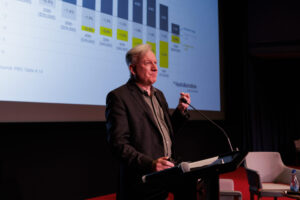by Richard Denniss
[Originally Published in the Australian Financial Review, 26 June 2019]
Imagine if the Reserve Bank of Australia (RBA) conducted monetary policy the way the Morrison government conducted fiscal policy. Step one: publish optimistic forecasts of GDP and wage growth to create “confidence”. Step two: set interest rates five years down the track, based on those optimistic forecasts. Step three: when the economy dramatically slows, stick with your original policy settings. What could go wrong?
The Australian economy needs to legislate $95 billion in tax cuts about as much as the government’s emission reduction targets need a new coal-fired power station. But hey, it’s 2019 and the truth is whatever powerful people forecast it to be. Angus Taylor tells us rising emissions are proof that global emissions are falling, and Josh Frydenberg tells us a slowing economy is proof we’re on the right track.
When it comes to monetary policy, everyone expects the RBA to deliver certainty in its goals (inflation of 2-3 per cent) and its actions (adjusting interest rates to achieve that goal). But when it comes to the government’s fiscal policy, it’s now impossible to tell how, or if, it will achieve its goals.
In 2014, the then employment minister Eric Abetz complained about “weak kneed employers caving in” to demands for wage rises. He went on to warn about a “wages explosion [reminiscent] of the pre-accord era, when unsustainable wage growth simply pushed thousands of Australians out of work”.
New round of reforms
Whatever Abetz said to the employers clearly worked because wage growth collapsed soon after. But it seems the last three Coalition treasurers never got the memo. For five years in a row, Treasury forecast that wage growth would pick up, when in reality it continued to fall. Whoops.
Despite the non-existent wage explosion and the fact that even the RBA says wage growth would be good for the economy, this week the Prime Minister announced a new round of reforms to crack down on the “militant unionism” he presumably thinks is to blame for the record low wages his government has overseen. Maybe Scott Morrison thinks wage growth is so low because the unions were pushing too hard? Maybe he thinks that if unions ask more politely, employers won’t be so “weak kneed”? While most economists agree that cutting interest rates will boost spending, it’s not at all clear how further industrial relations reform will boost wages. But who needs certainty when we have forecasts?
Then there’s fiscal policy. In 2014, when the budget deficit was $29.8 billion, the then treasurer Joe Hockey forecast that by 2017-18 the deficit would be down to just $2.8 billion. In reality, it was $29.4 billion that year. Whoops.
In this government’s first budget back in 2014, Hockey told us that having 700,000 unemployed people was too many and having net debt of $198 billion was too much. Today there are 705,000 unemployed people and the net debt has increased to $373 billion. After six years in office and six years of failing to solve either of these problems, you can see why the government is urgently trying to pass $95 billion in tax cuts for 2024. One thing is certain: the business community is less worried about a weak economy when you are cutting tax rates for Australia’s highest income earners.
Contrasting figures
Leading up to this year’s federal election campaign, Frydenberg told us the economy was on the right track and that, as a result of the strong economy, the budget would return to surplus in the coming financial year. Of course, since then the Bureau of Statistics, RBA and the private sector have all reported weaker economic figures than Frydenberg forecast in the budget. Whoops.
So, what’s a Treasurer to do? As his optimistic growth forecasts come unstuck, should he stick to his promises about a strong economy, or stick to his promises of an arbitrary budget surplus? Most economists, retailers and job seekers would prefer the Coalition prioritise the fiscal stimulus required to deliver growth over the fiscal constraint required to deliver a budget surplus. But the Treasurer has made clear he’ll be prioritising political symbolism over economic management.
Australia is a low tax, low debt country with a slowing economy. The economics textbooks – and the economic bureaucracy – know exactly what fiscal policy levers need pulling right now. But instead, the Coalition is determined to pass tax cuts today, that are likely to be inappropriate, inadequate or unaffordable in five years’ time.
Richard Denniss is chief economist at The Australia Institute @RDNS_TAI
Between the Lines Newsletter
The biggest stories and the best analysis from the team at the Australia Institute, delivered to your inbox every fortnight.
You might also like
Stage 3 Better – Revenue Summit 2023
Presented to the Australia Institute’s Revenue Summit 2023, Greg Jericho’s address, “Stage 3 Better” outlines an exciting opportunity for the government to gain electoral ground and deliver better, fairer tax cuts for more Australians.
18 Reasons why the Stage 3 tax cuts should be redesigned
Australia Institute research shows the Stage 3 income tax cuts are fiscally irresponsible, massively expensive and completely unfair.
Richard Denniss: National Press Club Address
On Wednesday, 31 January 2024, Richard Denniss and Allegra Spender MP addressed the National Press Club for a debate on the Stage 3 tax reforms. **Check against delivery** [See below for transcripts] Tax is good. Tax is an investment in our society and the highest taxed countries in the world also happen to be the



